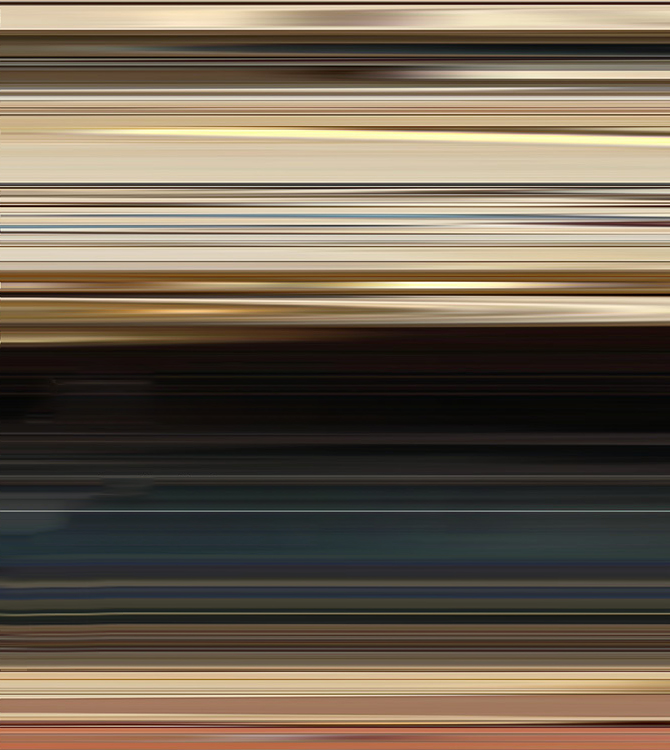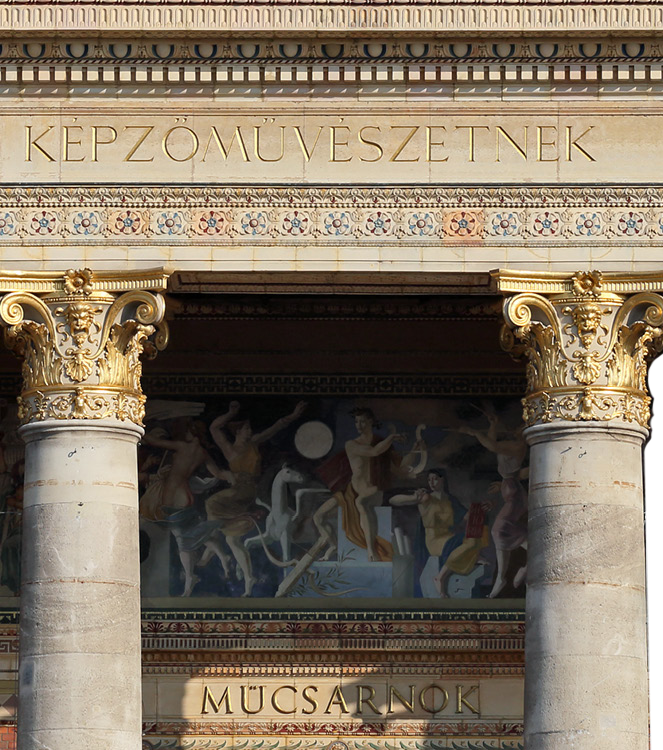



József Baksai chief curator, Katalin Kállai art consultant
Our virtual reality, which invaded our existing spaces with overwhelming intensity at the turn of the 21st century, now seeks to permeate our lives more carefully, with the utmost circumspection. Step by step. As the escalating digital revolution bombarded our daily lives with an increasingly unmanageable torrent of information, introducing newer and newer functions, it has, by now, rendered itself ultimately indispensable. It has created a digital culture that generates its own values, previously unknown, through infinite and irreconcilable contradictions.
So much so that human culture has awakened in a universe never seen before.
Is it an exaggeration to claim that this material world thrust into virtuality – with the ingenuity of the human mind in the background, of course – functions as living matter in its own intangible totality? A glowing, sizzling, undulating consciousness that, in its own defence, responds to the tradition-based questions posed by human culture with elemental force. Matter? A reality beyond matter? Tradition? The medieval theologian Duns Scotus’ concept applied to virtuality? The traditional forms of art? Artistic freedom created through digital means? Self-identity? Virtual identity? And once we got this far: the unrestricted replicability of digital artworks versus the uniqueness of tangible artistic objects? Very well. Non-fungible token.1
An irreplaceable object.
Unique and unrepeatable.
Yet, if we look back at the term ‘non-fungible object’ from the digital present, not just in its current context but in its traditional sense, it becomes bizarrely relevant to the entire realm of visual art. The contemporary ingenuity of its virtual metamorphosis captures something of the essence of art both before and after digitisation.
A striking change in contemporary art over the past five years is that even works created using traditional methods can no longer remain unaffected by the digital cosmos, which is racing at wind speed. This year’s National Salon of Fine Arts seeks to reflect the richness of personal responses to society’s shifts and, in doing so, to illustrate the infiltration of the emerging virtual world into traditional artistic thinking. It seeks to reveal a worldview reflecting upon our times, where the desire to rethink tradition coexists with the so-called digital mindset underpinning the tangible creations of the material world.
To reveal all that has become inseparable from our existence as attested to by the present artworks.
Whether this manifests in form and/or content – in constant interaction with reality – remains the artist’s individual decision. The finiteness of infinite content necessitates its own unique forms, whether it be the faint blue smile of two parallel lines of a structure indispensable to our existence, or the scream, frozen in marble, of the gorgon Medusa, emerging from a human torso with serpentine tentacles.
The third millennium, which challenges the traditional myths of human thought, has not only brought the latent cataclysms of our drastically globalising societal self-awareness to the surface – thereby liquefying the petrified structures of our social and intimate existence – but has also compelled an impassioned artistic response. Forms of doubt that have accompanied every phase of creation with increasing fervour. Artist do not merely cast a sceptical eye upon our daily existence but, more and more, upon themselves and the entirety of art, redirecting their quest leading through uncertainty towards the thought behind the visible.
In the silence of doubt, artists do not rest.
They seek connections with reality both within the realm of digitisation and beyond. They seek connections to themselves, ‘signalling’ their thoughts and summoning the art of nature from their innermost selves, while, in response to lost worlds, they conjure up the cheekily meaningful ‘great white nothing’... They hang fabric, fold material, enclose Trianon in an installation and the frenzied Ubu in a geometric coffin. They rewrite history. They pray with clasped hands, wearily resting... They doubt with faith.
A cry can be silent. It can be a mute, impassioned gesture, an exclamation mark sent out into the world. A gesture that, one way or another – whether silently or in a frenzy – breaks to the surface unstoppably. It can be the uncompromising, materialised body of our most profound anxieties and fears. The materialised body of hope suddenly surging in us. The body of the exhausted red forest, the exploding turquoise, the weighty yoke floating on its pedestal, the black density of asphalt, the impassable pathways of suddenly igniting light.
A response to tangible and intangible reality.
But more than that, it can be a question, faithfully representing our time, which speaks not only of the kamikaze adventure of – unique and unrepeatable – creation but also of the act itself, which leads from spontaneous external phenomena to the deepest recesses of the unconscious. Speaking of a journey that penetrates ever deeper into humanity’s collective consciousness.
The path that guides us, the one we are walking, arrives at a strikingly open realm. The house of feeling beings is a communal house. It belongs to all of us. To each of us capable of emotion. To those who rejoice, suffer, fear, love, feel pain, and experience the inimitable joy of existence.
...it is the realm of those beings the human language calls ‘animals’: uncannily wise, angelic creatures. Look at this company. We see serious, emotionally complex living beings who do not always understand humans but comprehend the world all the better. They endure what happens to them, yet they are strong, prepared to fight and self-aware.
...and it is the realm of those beings the human language calls ‘humans’: uncannily wise, angelic creatures. Look at this company. We see serious, emotionally complex living beings who do not always understand themselves and do not always understand the world.
They endure what happens to them, yet they are strong, prepared to fight and self-aware.
Although the ability of digital creation spectacularly separates the two, the connection between them is ever stronger.
Armed with an ever-deepening conscience, the twenty-first century, together with the most recent Hungarian art, is precisely aware of all this. A baseball cap with a puppy on the turning head of a child, death masks of anthropoids hanging on a wall, yellow and pink humanoids sleeping on a carpet, stylised human and animal heads around a well… Objects that, through their depictions of human and animal bodies, refer to the shared origin of their existence, their mutual vulnerability, their forced or voluntary symbiosis, and to the ontological elements that presuppose each other’s existence.
The desire to model reality tempts/haunts us all. The virtuality we have carried within us since prehistoric times – perception and intellect – enables us to gauge the structure of the tangible world more precisely than ever before and model existence using the systems and intricate web of networks the digitalised ‘new world’ has given us. And the impossible quest to understand the real world drifts into an increasingly unfathomable distance precisely because of this digitalised virtuality, which threatens us with its ever-condensing mass of information. The desired structure, which, laid over reality like grid to explain ‘everything’, is all but an illusion.
It is the illusion of artists, who dare believe in the impossible throughout their quest for the system beneath appearances.
They arduously seek the order that is hidden beneath the spectacle intruding upon our vision.
They seek the conceptual anchor – the structure of existence and its concealed interconnections – inherent in overlapping geometric shapes, wooden and metal objects, colourful networks of pipes, coiling strings and a yellow crowd of humans, which offer some kind of answer to reality, even if only for fleeting moments. Do we receive an unrepeatable, one-time placebo to heal our souls, or real forms that reveal invisible content taking shape in the depths? It does not matter, really. One way or another, it adds to our existence…
Bound by the numerology dictated by the new millennium, our changing world grits its teeth in a struggle to renew itself. Ingeniously, cunningly, mercilessly, demanding sacrifice. As always when profound change takes place, humanity’s perpetual fears take shape: natural disasters, pandemics, war, the dark web, destruction, digital slavery… The psyche longs for consolation: one that does not obscure reality but renders it tolerable; one that does not deny the trauma of facing the truth but harbours within it the possibility of absolution.
In the finite span of time, we seek forms of redemption that renew with each new era.
We seek new patterns that embrace the possibility of crossing the boundaries of genres, concepts and philosophies of art, made possible by the newly-found artistic tools. Possibilities that do not necessarily strive for definitive solutions but, on the contrary, their very essence is the courageously undertaken ‘unfinished’ act of seeking. Schrödinger’s unseen cat, neither alive, nor dead. The muse locked within itself, wrapped up for good. Two empty-eyed torsos, locked in an eternal gaze…
The current of time, or ‘flow’, can be ridden. The wave does not stop but it freezes for a moment if we so want. And a vision of the future – just like the past – emerges from that well-captured moment. Full of hope, dystopian, tendentious and divergent. Reflecting on the questions of society, the vates in artists condenses responses into the subjective.
A path?
A false path?
The space between the two? All three, together. A tank graveyard summoned from the future; a black-and-white real-life lake with competing, glowing-red virtual beings; a stunning female torso taking a selfie; a bizarre lightbox; a miniature forest growing from a tree stump; a searing lava flow engulfing everything; a Madonna from Mars; a neutered matrix composed only of zeroes and inscribed THE NOTHING THAT IS. These works, conceived in the shadow of looming threats, constitute discernible directions using their subjective means to explore the possibilities of our shared future along the most pressing issues of society: sustainable existence, nature doomed by the metropolis, the destructive force of real and virtual communal spaces, the human body and the technology that penetrates it.
Human beings, who cannot be replaced, who, drawing upon Duns Scotus’ centuries-old notion of virtuality, strive to synthesise their experience through decoding the surrounding world. Well, they are here… Creating. Perceiving, thinking, pushing against the limits of tradition. Their work, the Opus Magnum of all time, is far from being free from uncertainty, yet it signifies the very possibility of art’s unfettered freedom.
1 The ‘digitalised’ meaning of the term, which has become widespread over the past five years, is also an invention of the new millennium. It was created by the cryptoworld, founded by Satoshi Nakamoto, who remains completely unknown, and what it denotes is essentially a form of virtual content, assigned a digital identifier, with its ownership recorded on a – decentralised – network, in the blockchain that underpins cryptocurrencies. No matter how we look at it, it is unique